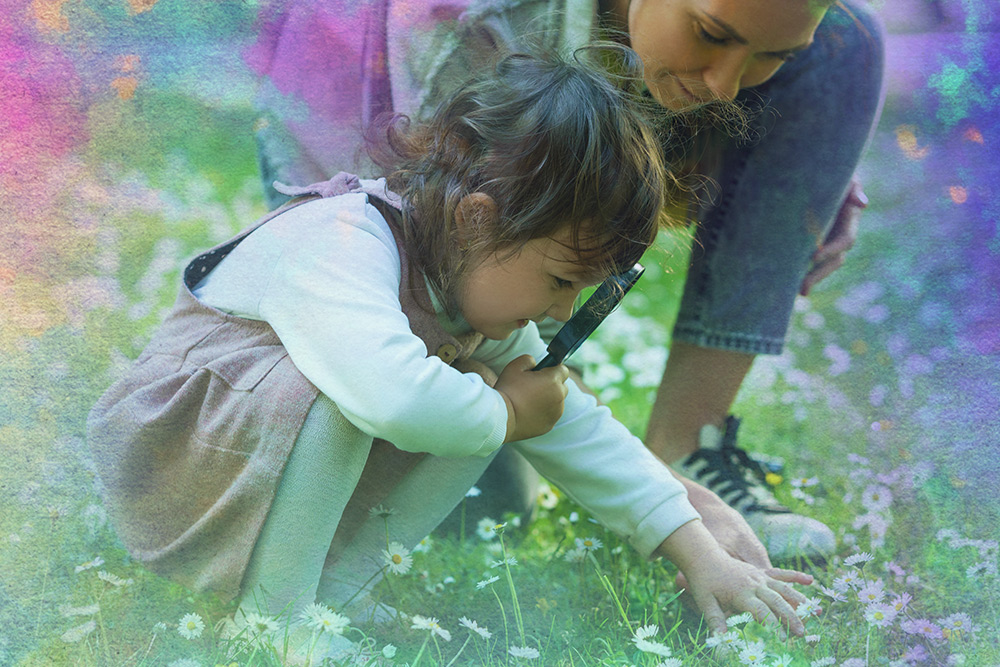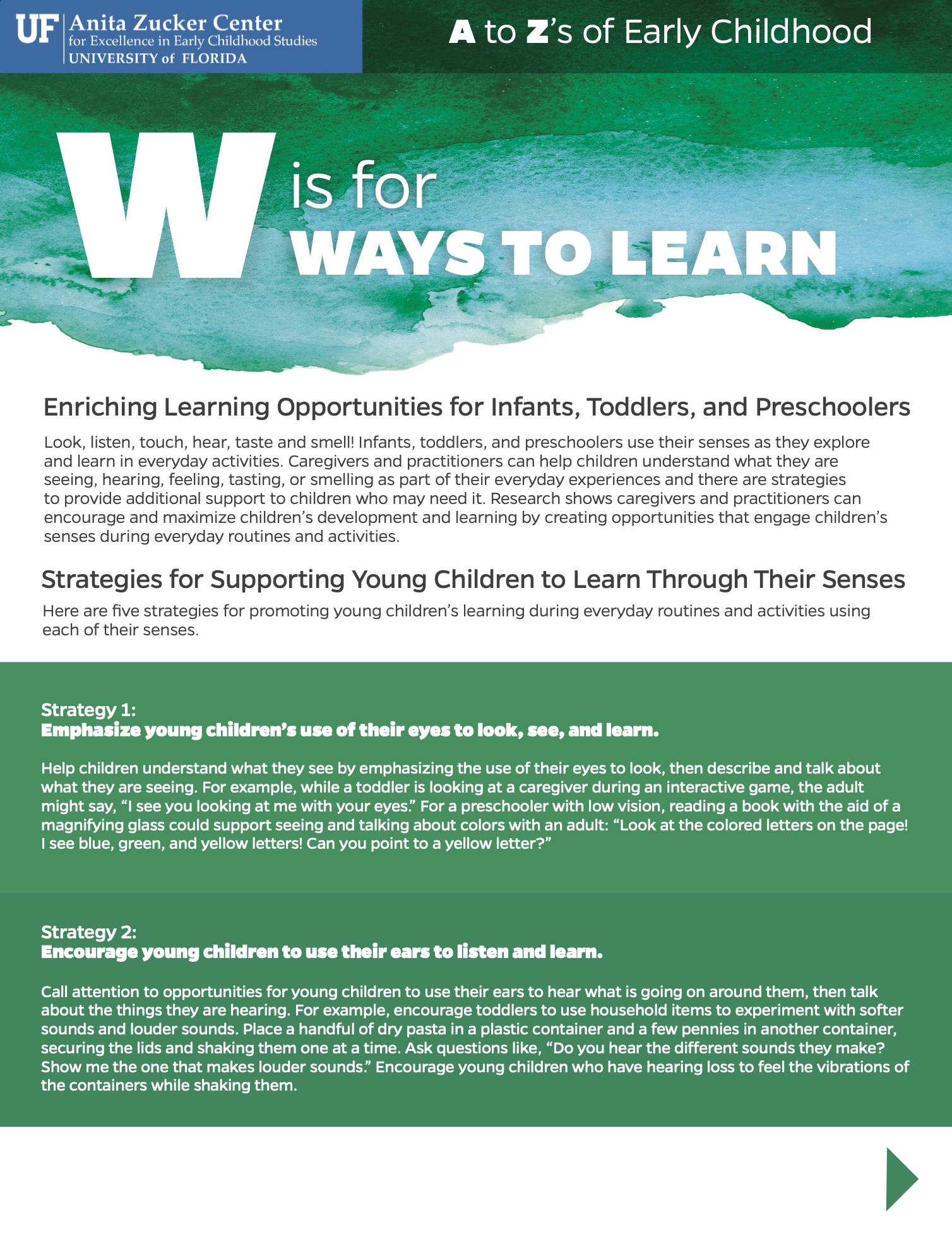A to Z’s of Early Childhood
The Science of Child Development and Learning
W is for Ways to Learn
Enriching Learning Opportunities for Infants, Toddlers, and Preschoolers
Look, listen, touch, hear, taste and smell! Infants, toddlers, and preschoolers use their senses as they explore and learn in everyday activities. Caregivers and practitioners can help children understand what they are seeing, hearing, feeling, tasting, or smelling as part of their everyday experiences and there are strategies to provide additional support to children who may need it. Research shows caregivers and practitioners can encourage and maximize children’s development and learning by creating opportunities that engage children’s senses during everyday routines and activities.

Strategies for Supporting Young Children to Learn Through Their Senses
Here are five strategies for promoting young children’s learning during everyday routines and activities using each of their senses.
Strategy 1: Emphasize young children’s use of their eyes to look, see, and learn.
Help children understand what they see by emphasizing the use of their eyes to look, then describe and talk about what they are seeing. For example, while a toddler is looking at a caregiver during an interactive game, the adult might say, “I see you looking at me with your eyes.” For a preschooler with low vision, reading a book with the aid of a magnifying glass could support seeing and talking about colors with an adult: “Look at the colored letters on the page! I see blue, green, and yellow letters! Can you point to a yellow letter?”
Strategy 2: Encourage young children to use their ears to listen and learn.
Call attention to opportunities for young children to use their ears to hear what is going on around them, then talk about the things they are hearing. For example, encourage toddlers to use household items to experiment with softer sounds and louder sounds. Place a handful of dry pasta in a plastic container and a few pennies in another container, securing the lids and shaking them one at a time. Ask questions like, “Do you hear the different sounds they make? Show me the one that makes louder sounds.” Encourage young children who have hearing loss to feel the vibrations of the containers while shaking them.
Strategy 3: Invite young children to use their sense of touch to feel and learn.
Children’s sense of touch can help them explore new ideas and learn from them. Provide a variety of fun and interesting ways for infants, toddlers, and preschoolers to explore their world through their sense of touch. For example, when encouraging an older infant who is sensitive to different food textures to try a new food, encourage them to feel the food’s textures by touching the food with their fingers first.
Strategy 4: Support young children to use their sense of taste to learn.
Young children learn about taste by trying a variety of foods and drinks. Talking about tastes they enjoy or might not enjoy helps young children increase their awareness of different tastes and builds early language and social skills. For example, you can provide a toddler with a variety of fruits to taste (e.g., mashed bananas, apple, and watermelon) and ask them about each one (e.g., “Is the applesauce sweet?”) and wait for their reply. These back-and-forth exchanges support positive relationships and healthy eating habits.
Strategy 5: Provide opportunities for young children to use their nose to learn through their sense of smell.
All of us, including infants, toddlers, and preschoolers, encounter many different scents as we engage in everyday activities and routines. As children interact with different scents, encourage them to use their nose to learn and talk about what they are smelling. For example, you can add different scents (e.g., cocoa or peppermint extract) to pieces of playdough and place each one in a jar. Encourage preschoolers to pick up each jar and smell it while asking them questions (e.g., “What do you smell? Is it sweet?”).
What We Are Doing
The Anita Zucker Center and our collaborators are helping families and practitioners learn effective ways to maximize young children’s development and learning by creating opportunities that engage their senses during everyday routines and activities.
Learn More:
Embedded Instruction for Early Learning
Embedded Instruction for Early Learning applies the 3R’s of Early Learning: Relationships, Repetition, Routines ™ to help children learn important skills during everyday activities with familiar people at home, in early learning programs, and in the community and is recognized internationally as a recommended practice
Embedded Instruction for Early Learning, California
The Embedded Instruction grant connects the California Department of Education’s Desired Results Developmental Profile assessment to the California Early Learning Foundations and classroom curricular and instructional practices to strengthen the relationship between assessment and instruction and provide planned and intentional instruction for children with disabilities during everyday activities. Embedded instruction helps preschool teachers understand the three principles of UDL.
CHILD Center for Early Learning
The Anita Zucker Center partners with local groups, including the Southwest Advocacy Group (SWAG), the Early Learning Coalition of Alachua County, and Episcopal Children’s Services to maintain the CHILD Center for Learning, a model high-quality early care and education demonstration program for young children in Gainesville, FL. Principles of UDL were used to design the CHILD Center and to inform classroom environments, materials, and interactions.
Other Resources
Incorporate Sensory Activities and Choices Into the Classroom
This article advocates for sensory activities to be routinely incorporated into a classroom learning environment. Allowing children to freely choose sensory activities lets them decide what their bodies need to feel comfortable and continue learning.
Picky Eaters and What To Do
This webpage from the Centers for Disease Control and Prevention (CDC) gives tips on how to introduce new foods to young children who have sensitivities to different tastes and textures.
Articles by Center Members and Collaborators
- Newton, D. A., Eren, R., Ben-Avie, M., & Reichow, B. (2013). Technology in action. Journal of Special Education Technology, 28(2), 53-56. https://doi.org/10.1177/016264341302800205
References
- Bales, K. L., Witczak, L. R., Simmons, T. C., Savidge, L. E., Rothwell, E. S., Rogers, F. D., Manning, R. A., Heise, M. J., Englund, M., & Arias Del Razo, R. (2018). Social touch during development: Long-term effects on brain and behavior. Neuroscience and Biobehavioral Reviews, 95, 202-219. https://doi.org/10.1016/j.neubiorev.2018.09.019
- Bertenthal, B. I., Boyer, T. W., & Harding, S. (2014). When do infants begin to follow a point?. Developmental Psychology, 50(8), 2036-2048. https://doi.org/10.1037/a0037152
- Coulthard, H., & Sealy, A. (2017). Play with your food! Sensory play is associated with tasting of fruits and vegetables in preschool children. Appetite, 113, 84-90. https://doi.org/10.1016/j.appet.2017.02.003
- Fernand, J. K., Penrod, B., Fu, S. B., Whelan, C. M., & Medved, S. (2016). The effects of choice between nonpreferred foods on the food consumption of individuals with food selectivity. Behavioral Interventions, 31(1), 87-101. https://doi.org/10.1002/bin.1423
- Goodwyn, S. W., Acredolo, L. P., & Brown, C. A. (2000). Impact of symbolic gesturing on early language development. Journal of Nonverbal Behavior, 24(2), 81-103. https://doi.org/10.1023/A:1006653828895
- Lock, R. H., & Prestia, K. (2004). Incorporate sensory activities and choices into the classroom. Intervention in School and Clinic, 39(3), 172-175. https://doi.org/10.1177/10534512040390030701
- Parlakian, R. (2010). Beyond twinkle, twinkle: Using music with infants and toddlers. Young Children, 65(2), 14-19. https://eric.ed.gov/?id=EJ898687
- Schwarz, T., & Luckenbill, J. (2012). Let’s get messy!: Exploring sensory and art activities with infants and toddlers. Young Children, 67(4), 26-30, 32, 34. https://eric.ed.gov/?id=EJ992256
- Staley, L. (1997). Teaching strategies: “What does purple smell like?”. Childhood Education, 73(4), 240-242. https://doi.org/10.1080/00094056.1997.10521103
Additional References
- Ard, L. M., & Beverly, B. L. (2004). Preschool word learning during joint book reading: Effect of adult questions and comments. Communication Disorders Quarterly, 26(1), 17-28. https://doi.org/10.1177/15257401040260010101
- Britto, P. R., Brooks‐Gunn, J., & Griffin, T. M. (2006). Maternal reading and teaching patterns: Associations with school readiness in low‐income African American families. Reading Research Quarterly, 41(1), 68-89. https://doi.org/10.1598/RRQ.41.1.3
- Deckner, D. F., Adamson, L. B., & Bakeman, R. (2006). Child and maternal contributions to shared reading: Effects on language and literacy development. Journal of Applied Developmental Psychology, 27(1), 31-41. https://doi.org/10.1016/j.appdev.2005.12.001
- Fletcher, K. L., & Reese, E. (2005). Picture book reading with young children: A conceptual framework. Developmental Review, 25(1), 64-103. https://doi.org/10.1016/j.dr.2004.08.009
- Fletcher, K. L., Cross, J. R., Tanney, A. L., Schneider, M., & Finch, W. H. (2008). Predicting language development in children at risk: The effects of quality and frequency of caregiver reading. Early Education and Development, 19(1), 89-111. https://doi.org/10.1080/10409280701839106
- Hammer, C. S., Nimmo, D., Cohen, R., Draheim, H. C., & Johnson, A. A. (2005). Book reading interactions between African American and Puerto Rican Head Start children and their mothers. Journal of Early Childhood Literacy, 5(3), 195-227. https://doi.org/10.1177/1468798405058683
- Horowitz‐Kraus, T., & Hutton, J. S. (2015). From emergent literacy to reading: How learning to read changes a child’s brain. Acta Paediatrica, 104(7), 648-656. https://doi.org/10.1111/apa.13018
- Karrass, J., & Braungart-Rieker, J. M. (2005). Effects of shared parent–infant book reading on early language acquisition. Journal of Applied Developmental Psychology, 26(2), 133-148. https://doi.org/10.1016/j.appdev.2004.12.003
- Marchman, V. A., & Fernald, A. (2008). Speed of word recognition and vocabulary knowledge in infancy predict cognitive and language outcomes in later childhood. Developmental Science, 11(3), F9-F16. https://doi.org/10.1111/j.1467-7687.2008.00671.x
- Pickron, C. B., Iyer, A., Fava, E., & Scott, L. S. (2018). Learning to individuate: The specificity of labels differentially impacts infant visual attention. Child Development, 89(3), 698-710. https://doi.org/10.1111/cdev.13004
- Roberts, J., Jergens, J., & Burchinal, M. (2005). The role of home literacy practices in preschool children’s language and emergent literacy skills. Journal of Speech, Language, and Hearing Research, 48(2), 345-359. https://doi.org/10.1044/1092-4388(2005/024)
Receive Additional Support
The complete 3R’s of Early Learning downloadable video recordings (including the A to Z’s of Early Childhood) for use in the field of childhood development to facilitate learning are available for purchase.
If you would like to purchase these resources or speak with a member of our team for help in providing professional development, please complete this contact form.

